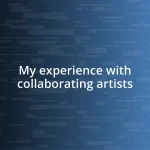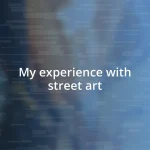Key takeaways:
- Collaboration enriches artistic perspectives, emphasizing the importance of shared vision, vulnerability, and open communication to foster deeper connections.
- Effective project management, including clear goals and regular check-ins, is crucial in navigating challenges and adapting creatively through partnerships.
- Embracing and celebrating both successes and lessons learned enhances the collaborative experience, making it more rewarding and memorable for all involved.

My journey in artist collaboration
Collaboration has been a transformative part of my artistic journey. I still remember the first time I teamed up with a fellow artist; it felt almost surreal. Seeing two different styles blend seamlessly into one piece was like witnessing magic. Have you ever felt that electric buzz when your ideas align with someone else’s?
One project that stands out was a mural I painted alongside a street artist. We spent hours discussing our visions, and I was amazed at how our creative energies were different yet complementary. It taught me the importance of listening—sometimes, the best ideas stem from the most unexpected conversations. Have you ever experienced that breakthrough moment when a collaborative effort sparks something you couldn’t achieve alone?
Reflecting on my collaborations, I realize how each partnership has enriched my perspective as an artist. I’ve found that vulnerability is key; sharing our fears and aspirations opens doors to deeper connections. Isn’t it fascinating how collaboration can transform personal struggles into shared triumphs? These experiences have not only shaped my work but have deepened my appreciation for the diverse talents of those around me. Each collaboration serves as a reminder that art, at its core, is about connection.

Understanding the importance of collaboration
Collaboration in art is essential because it creates a synergy that can lead to extraordinary results. I remember a time when I joined forces with a musician to create an audio-visual installation. As we merged our crafts, I felt an exhilarating rush—the art became a living entity. It’s incredible how different mediums can come together to evoke emotions that are deeper and more resonant than either could achieve individually. When you collaborate, you open the door to fresh ideas and perspectives that challenge your own.
Moreover, working with others fosters a sense of community and shared purpose. I once collaborated on a community art project where artists and local residents came together to design a public space. The joy and pride in seeing our collective vision come to life was unlike anything I’d ever experienced. It really reinforced the belief that together, we can solve problems and innovate in ways we might never explore alone. Aren’t those moments of unity what art is all about?
On a more personal note, embracing collaboration has taught me resilience. In one instance, a project with a fellow artist fell through right before the deadline. Instead of crumbling, we pivoted our efforts and created a completely new piece that resonated with our shared experiences. It reminded me that collaboration isn’t just about merging talents; it’s also about adapting and growing through challenges. Hasn’t every artist faced their share of obstacles? Finding strength in partnership can transform setbacks into beautiful opportunities.
| Importance of Collaboration | Personal Insights |
|---|---|
| Synergy of Ideas | Creating exhilarating experiences through merging different art forms. |
| Community Building | Fostering connections that lead to impactful projects. |
| Resilience | Adapting and growing together in the face of challenges. |

Finding the right collaborators
Finding the right collaborators is a critical step in any artistic journey. I’ve learned that aligning not just on vision but on values is essential. For example, I once connected with an artist whose approach to sustainability resonated deeply with me. As we brainstormed, I could see how our shared commitment to the environment infused an authenticity into our project, enhancing the message we hoped to convey. It felt like finding a puzzle piece that completed the picture.
Here are a few key considerations when searching for the right collaborator:
– Shared Vision: Look for someone who envisions the project similarly to you.
– Complementary Skills: Find artists whose strengths balance your own weaknesses.
– Open Communication: Ensure that both parties are comfortable expressing ideas and concerns.
– Respect for Each Other’s Craft: Mutual respect can foster creativity and trust.
– Shared Values: Collaborating becomes richer when both of you stand for the same principles, whether that’s sustainability, community, or artistic integrity.
In retrospect, I realize how vital it is to trust your instincts during this process. I remember a particular collaboration that initially seemed promising but quickly soured due to differing priorities. The experience was a tough lesson, teaching me to prioritize chemistry over credentials. Each collaboration has a unique rhythm—when it clicks, it’s exhilarating and expansive. When it’s off, it can feel constraining and disheartening. Always go where the creative energy flows freely!

Communicating effectively with artists
Effective communication with artists is crucial for a successful collaboration. I vividly recall a time when I was working with a painter on an installation. We would meet regularly to share ideas and sketches, but what truly made a difference was the open space for honest feedback. This back-and-forth dialogue not only clarified our vision but also deepened our connection. Have you ever felt that thrill in expressing yourself freely and seeing the reflections of your thoughts in another’s work?
Listening is just as important as speaking in these creative partnerships. During a collaborative project with a graphic designer, I noticed how my simple act of listening to her commentary led to some of our best concepts. When I gave her space to share her perspective, it sparked insights that I hadn’t considered. Isn’t it amazing how effective communication can reveal hidden gems within ideas?
Furthermore, I’ve found that employing visual aids can bridge communication gaps. When words failed us during a particularly complex project with a musician, we started metaphorically drawing our ideas on a whiteboard. This visual approach not only clarified our intentions but also injected a sense of fun into our collaboration. Sometimes, the best breakthroughs arise from the simplest methods! How often do we overlook the power of visuals in articulating our vision?

Setting clear goals and expectations
Setting clear goals and expectations is essential for a fruitful collaboration. I remember a project where we started with a vague idea of what we wanted to create, but it quickly became chaotic. Our initial meetings were filled with excitement, yet that enthusiasm could’ve been harnessed better with defined objectives. How could we have known that a simple outline would streamline our creative process? From that experience, I’ve realized it’s crucial to articulate not just what we want to achieve, but also how we’ll measure success along the way.
Another important aspect I learned is to establish roles and responsibilities upfront. In one collaboration, we both ended up stepping on each other’s toes because we hadn’t delineated who was responsible for what. I found myself juggling tasks that I initially agreed to leave to my collaborator, which not only created tension but also muddied the creative waters. Have you ever found yourself in a situation like that? It’s a reminder that clear boundaries foster creativity rather than hinder it; they allow each artist to shine in their respective areas.
I also advocate for regular check-ins during a project. It’s easy to get lost in the creative whirlwind, so recording our progress and revisiting our goals became a vital practice for me. I once dedicated half an hour every two weeks to assess our progress, and surprisingly, it reignited our motivation. This simple ritual transformed our collaboration from just a task into a dynamic partnership. Isn’t it comforting to know that a little structure can fuel artistic fluency?

Navigating creative differences
Navigating creative differences can be a delicate dance. I once teamed up with a sculptor whose vision was radically different from mine. At first, it felt like we were pulling in opposite directions, causing frustration on both sides. But instead of pushing our ideas into a corner, we decided to hold a brainstorming session where we openly presented our concepts. It was enlightening to witness the rich tapestry of ideas that emerged when we each embraced the other’s perspective. Have you felt that rush when conflicting ideas come together to create something unexpected?
I’ve learned that acknowledging the emotional aspect of creativity is crucial. During a project with a photographer, we faced a particularly heated moment when our styles clashed. Rather than get defensive, I took a step back and shared how passionate I felt about my approach. It opened the door for him to express his concerns as well, and in that moment of vulnerability, we discovered a shared goal: creating something that resonated genuinely with both our artistic visions. Doesn’t it feel liberating when you can turn friction into a collaborative force?
Sometimes, it’s all about compromise and flexibility. In one memorable collaboration, we hit a brick wall over the colors for a mural. Instead of adhering rigidly to our differing views, we decided to create multiple mock-ups, blending our styles. The result was something entirely new—a palette that neither of us would have chosen alone, yet it epitomized the essence of our partnership. I often reflect on that experience; how can we transform our differences not into obstacles, but stepping stones for creativity?

Celebrating successes and lessons learned
Reflecting on successful collaborations, I find that celebrating shared achievements is vital. For instance, after completing a community mural project, we gathered with local residents to unveil it together. The joy in their eyes was unforgettable; it truly drove home how our teamwork could create something meaningful that resonated with others. Have you ever felt that sense of pride when your collective efforts shine through in a finished piece? It’s like the universe giving you a high five!
Lessons learned often hold the same weight as our victories. One time, after a project didn’t quite hit the mark, I felt deflated. However, instead of wallowing in what went wrong, we turned that moment into a reflective session. We discussed our missteps openly, leading to a remarkable revelation: failure can be a powerful teacher. It’s fascinating how those difficult conversations can unearth insights that pave the way for future success. How often do we overlook the value in our setbacks?
I’ve come to appreciate the importance of acknowledging progress, no matter how small. I remember wrapping up a collaboration where we celebrated not just the completed work but every breakthrough, every moment of clarity. Each step, whether a minor adjustment or a significant milestone, was marked with a cheer or a small note of appreciation. Doesn’t it feel more rewarding when we recognize and celebrate the journey, not just the destination? It makes every experience more enriching and memorable.












